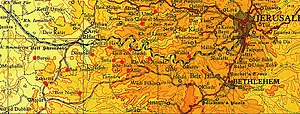Khirbat al-Tannur
| Khirbat al-Tannur | |
|---|---|
 |
|
| Arabic | خربة التنور |
| Name meaning | "The lower Allar" |
| Subdistrict | Jerusalem |
| Coordinates | 31°42′50″N 35°02′50″E / 31.71389°N 35.04722°ECoordinates: 31°42′50″N 35°02′50″E / 31.71389°N 35.04722°E |
| Palestine grid | 154/124 |
| Population | 400 (19th century) |
| Date of depopulation | October 21, 1948 |
| Current localities | Mata |
Khirbat al-Tannur (Arabic: خربة التنور), also Allar al-Sifla ("Lower Allar"), was a Palestinian Arab hamlet in the Jerusalem Subdistrict, near Allar. It was depopulated during the 1948 Arab–Israeli War on October 21, 1948 under Operation Ha-Har. It was located 18.5 km west of Jerusalem.
Ein Tanur ("Oven Spring") is a spring enhanced by an ancient tunnel dug deeply to catch the water at the source and increase its flow - a so-called spring-flow tunnel. According to a legend recounted by the mukhtar of Allar, Noah's oven was located here before the flood. When God destroyed the world, Noah's oven began spouting water, proving Noah's great commitment to God. When the flood was over and the water subsided, the oven forgot its original purpose and water continued to flow from it. When Noah passed by in his ark, he only saw the spring rather than his oven, so he continued his journey and finally landed on Mount Ararat.
In the 12th century, during the Crusader era, a rural monastery was established consisting of several barrel-vaulted buildings, an enclosure wall and a chapel. British archaeologist Denys Pringle proposed that the complex was a known Cistercian house called "Saluatio" established in 1169.
In the 13th century it was recorded in two documents that income from the village supported the Madrasa al-Mu'azzamiyya, north of the Haram al-Sharif in Jerusalem.
In 1596, the village appeared in Ottoman tax registers as Allar as-Sufla in the Nahiya of Quds in the Liwa of Quds (Jerusalem). It had a population of 7 Muslim households and paid taxes on wheat, barley, summer crops and olives. A visitor in 1875 wrote that it had a population of 400, but soon afterwards it was apparently abandoned until the 20th century.
...
Wikipedia

